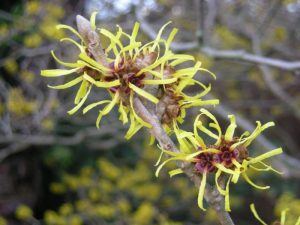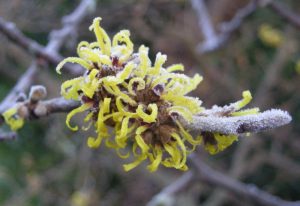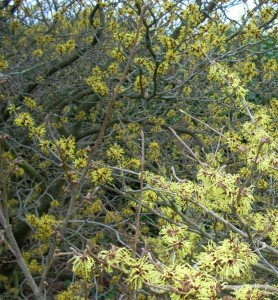The thin, ribbon-like petals and delicate scent of the Chinese witch hazel, Hamamelis mollis, welcomes you on entry to the Garden via the East Gate.
This deciduous shrub readily scents the area around it – it is best appreciated in the early morning when the air is still and other competing smells are reduced. The Phenology team recorded this plant’s first flowering of the season on 5 December 2007 but not until 11 December in 2006. From these dates it then takes until early January to be appreciated in full bloom.
Flowering magnificently this month, the paper-thin petals, being almost devoid of moisture, are rarely damaged during frost unlike Viburnum x bodnantense, of which a combination of frost and early sun will cause mass discolouration.
The flower clusters are produced on the previous season’s growth. Encased in brown felted sepals the hardly discernable flower parts are held deep within these. Individual flowers are grouped in clusters of three or four, accentuating the mass colour and the contrast of the recurved ruby red sepals and yellow ribbon petals.
The growth buds are covered in minute hairs and resemble the hoof of a deer. Deciduous, the plants also come into their own during autumn with yellow and red pigments through the leaves. This is a strong growing plant that appreciates full sun and a well-drained root run. It dislikes root disturbance and pruning but appreciates a top dressing of well rotted organic matter after flowering.
The cultivar H. mollis ‘Pallida’ also flowers reliably each year and boasts sulphur yellow petals. It tends to initiate bloom slightly later than the species. Both are in full colour west of the Alpine House, where the contrast in flower colour can be appreciated.
Kalmthout Arboretum in Belgium is holding a Hamamelis festival, from 14 January to 17 February 2008. Here the collection of Hamamelis species, hybrids and cultivars can be appreciated. Also, from 7 to 10 February, Kalmthout is staging an International Helleborus show.



